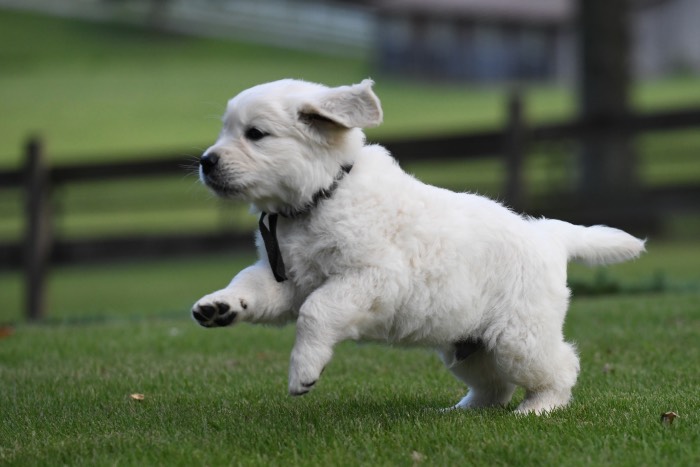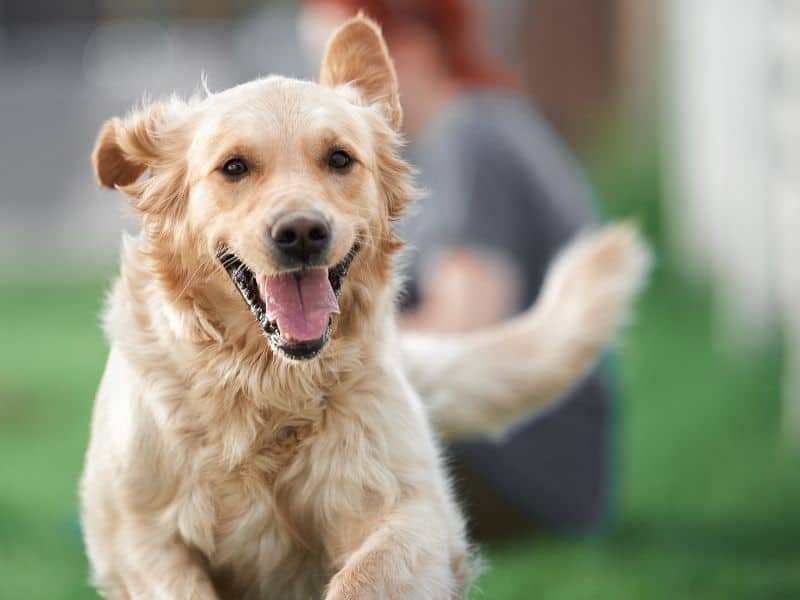If you’re wondering, “When can I take my golden retriever running?” you’ve come to the right place! Golden retrievers are known for their love of outdoor activities, and running can be a great way to keep them active and happy. But before you hit the pavement together, it’s important to consider a few factors.
First, it’s crucial to wait until your golden retriever is fully grown before starting them on a running routine. Generally, this happens around 1 to 2 years of age. This allows their bones, joints, and muscles to develop properly, reducing the risk of injury.
Another important aspect to consider is your dog’s overall health and fitness level. Just like humans, dogs need to build up their endurance gradually. Start with shorter, slower runs and gradually increase the distance and speed over time. This way, you’ll give your furry friend a chance to build up their stamina and avoid overexertion.
So, when can you take your golden retriever running? Once they reach adulthood and are in good health, you can start incorporating running into their exercise routine. Remember to start slow, be mindful of their limitations, and always keep an eye out for signs of fatigue or discomfort. Happy running with your golden retriever!
Wondering when you can start taking your golden retriever running? It’s important to consider their growth and development. Puppies are usually not ready for long runs until they are at least one year old. Even then, it’s best to start with short, controlled runs and gradually increase the distance as they build endurance. Always consult with your veterinarian to ensure your golden retriever is in good health before beginning any strenuous exercise routine.

When Can I Take My Golden Retriever Running?
Golden Retrievers are active and energetic dogs that require regular exercise to stay healthy and happy. Many dog owners wonder when it is safe to start taking their Golden Retriever running with them. In this article, we will explore the various factors to consider before introducing running to your Golden Retriever’s exercise routine. We will discuss the age and physical development of your dog, potential health concerns, training considerations, and tips for getting started. By the end of this article, you will have a clear understanding of when it is appropriate to take your Golden Retriever running and how to do it safely.
The Physical Development of a Golden Retriever
The physical development of a Golden Retriever plays a crucial role in determining when they are ready for running. Puppies go through various growth stages, and their bones, muscles, and joints need time to develop and strengthen. As a general rule, it is best to wait until your Golden Retriever is at least 12 to 18 months old before starting them on a running routine. This allows their bodies to mature and reduces the risk of injury. It is always recommended to consult with your veterinarian to ensure your dog is physically ready for running.
During the first year of a Golden Retriever’s life, their growth plates are still developing. These growth plates are areas of cartilage located near the ends of the long bones. They are softer and more prone to injury than the fully formed bones of adult dogs. Intense exercise, such as running, can put stress on these growth plates and increase the risk of developing skeletal problems. Waiting until your Golden Retriever reaches their adolescent stage and their growth plates have closed will help minimize these risks.
In addition to age, it is important to consider the fitness level of your Golden Retriever. Just like humans, dogs need to build their endurance gradually. Starting with shorter walks and gradually increasing the intensity and duration of the exercise will help prevent fatigue and injury. It is also essential to pay attention to your dog’s behavior during and after exercise. If they show signs of exhaustion, lameness, or discomfort, it may be an indication that they need to build up their fitness level before attempting running.
Health Considerations
Before engaging in a running routine with your Golden Retriever, it is crucial to ensure they are in good overall health. Regular veterinary check-ups are essential to monitor your dog’s well-being and address any underlying health conditions. Conditions such as hip dysplasia, heart problems, arthritis, or other joint issues can affect your dog’s ability to handle the impact and stress of running. Your veterinarian can provide guidance on the best exercise routine for your dog based on their specific health needs.
Another important aspect to consider is the weather conditions. Golden Retrievers have a thick double coat that can make them more susceptible to overheating. Running in extreme heat or high humidity can put your dog at risk of heatstroke. It is recommended to schedule runs during cooler parts of the day, such as early morning or late evening. Always carry water for your dog and watch for signs of exhaustion or overheating, such as excessive panting, drooling, or difficulty breathing.
Additionally, it is essential to ensure your Golden Retriever is up to date on vaccinations and protected against fleas, ticks, and other external parasites. Running in outdoor areas can expose your dog to these pests, so proper prevention measures should be in place to keep them safe and healthy.
Training Considerations and Tips
When introducing running into your Golden Retriever’s exercise routine, it is important to start slowly and gradually increase the intensity and duration of the runs. This allows your dog’s muscles and cardiovascular system to adapt to the new activity. Begin with shorter bursts of running interspersed with walking or slower paced exercises. Over time, you can gradually increase the running intervals while monitoring your dog’s response.
Proper leash manners are important when running with your Golden Retriever. Invest in a quality, comfortable leash and harness that allows for safe and controlled movement. Teach your dog to walk and run politely on a loose leash to ensure a pleasant running experience for both of you. Positive reinforcement training techniques can be highly effective in teaching your dog to follow commands and maintain good behavior during runs.
Incorporating variety into your running routine can be beneficial for both you and your Golden Retriever. Explore different routes, terrains, and environments to keep the experience engaging and stimulating. This will help prevent boredom and ensure your dog remains excited and motivated during the runs.
Conclusion
Knowing when to start running with your Golden Retriever is essential to protect their overall health and well-being. Waiting until your dog is physically mature and in good health, gradually building their endurance and fitness level, and considering factors such as weather conditions are key to a safe and enjoyable running experience. Always consult with your veterinarian for personalized advice and guidance specific to your Golden Retriever’s needs. Remember to listen to your dog’s cues and adjust the running routine accordingly. With patience, proper training, and care, you and your Golden Retriever can enjoy the benefits of running together.
When Can I Take My Golden Retriever Running?
Here are five key takeaways for you and your 13-year-old kid:
- It is best to wait until your golden retriever is at least 1 year old before starting running activities with them.
- Ensure your golden retriever has completed basic obedience training before introducing them to running.
- Gradually build up your golden retriever’s stamina and endurance through a structured exercise routine.
- Consider the weather conditions and avoid running with your golden retriever during extreme heat or cold.
- Monitor your golden retriever for signs of exhaustion or injury during runs and adjust the intensity accordingly.
Frequently Asked Questions
When it comes to taking your golden retriever running, there are a few factors to consider for their safety and well-being. Here are some commonly asked questions to help you determine the right time to take your furry friend out for a run.
What age should my golden retriever be before I can take them running?
Your golden retriever’s joints and bones are still developing until they are at least 12 to 18 months old. It’s essential to wait until they reach this age before starting rigorous running activities. Consult with your veterinarian, as they can provide personalized advice based on your dog’s health and development.
Starting running too early can potentially lead to musculoskeletal issues such as joint problems or growth plate injuries, which may result in long-term complications. Give your golden retriever’s body the time it needs to fully mature, ensuring a healthier and happier running experience later on.
What signs should I look for to know if my golden retriever is ready to run?
Before taking your golden retriever running, observe their behavior during regular walks or play sessions. Look for signs of enthusiasm, stamina, and sustained energy levels. Your dog should have no difficulty keeping up with you and display an eagerness to move at a faster pace.
Additionally, watch for any signs of fatigue or discomfort during walks, such as excessive panting, lagging behind, or limping. If your golden retriever is consistently showing these signs, it’s best to wait before introducing running into their routine. Remember, gradual progress is key to preventing injuries and ensuring a positive running experience for your four-legged friend.
Are there any weather conditions I should consider when taking my golden retriever running?
Extreme heat or cold can be dangerous for any dog, including golden retrievers. When planning a running session, it’s crucial to consider the weather conditions. Avoid running with your golden retriever during the hottest part of the day, as they may overheat and become at risk for heatstroke. Opt for early mornings or evenings when the temperature is cooler.
In colder weather, protect your golden retriever from freezing temperatures by providing them with a suitable dog coat. Monitor their paws for signs of discomfort or ice accumulation, as this can lead to injuries. Always prioritize your dog’s comfort and safety when determining the right time for a run.
How should I prepare my golden retriever for a running session?
Prior to starting a running routine with your golden retriever, ensure that they are in good overall health. Schedule a check-up with your veterinarian to address any potential health concerns.
Consider starting with shorter, slower runs and gradually increase the duration and intensity over time. This approach allows your golden retriever’s body to adjust and build endurance, reducing the risk of injuries. Don’t forget to warm up before each run with a brisk walk to prepare their muscles for exercise. And always carry water for both you and your dog to stay hydrated during the run.
What are some signs that indicate my golden retriever may be overexerted during a run?
It’s essential to pay attention to your golden retriever’s body language during a run. Signs of overexertion can include excessive panting that does not subside, slowing down significantly, stumbling, or refusing to continue running. If you notice any of these signs, it’s crucial to stop and rest.
Giving your golden retriever regular breaks during the run and providing water are also important to prevent dehydration and overexertion. Remember, it’s better to play it safe and take things slowly, especially if your golden retriever is new to running or hasn’t been active for an extended period.

How Fast Can a Golden Retriever Run?
Summary
Golden retrievers can start going on short runs at around 12 to 18 months old. Remember to start slow and gradually increase the distance to avoid any injuries. It’s important to consider your dog’s size, health, and fitness level before taking them running. Always consult with your veterinarian for the best advice.
Golden retrievers have a lot of energy and love exercise, so running can be a great activity for them. Just make sure to provide plenty of water and rest breaks during the run. Starting at the right age and taking it slow will help keep your golden retriever happy and healthy.
